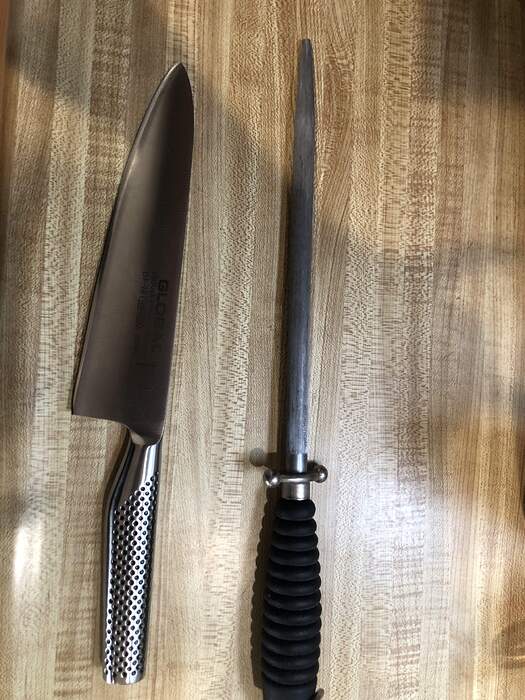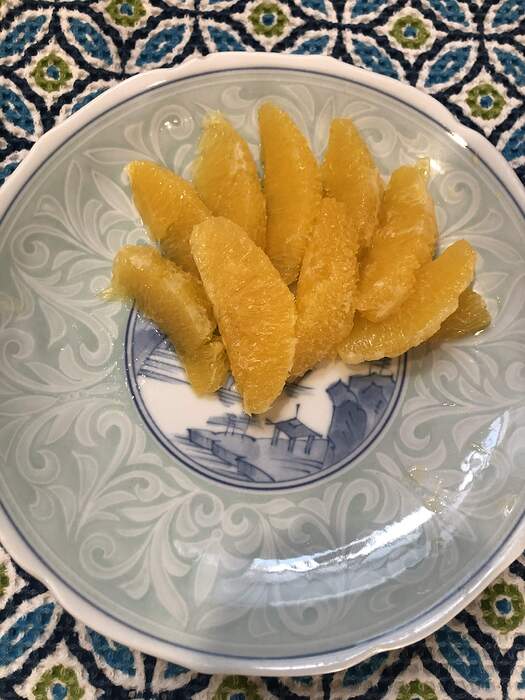I have been cooking since the 1960s. I have had enough knives to fill a good sized block. I have tried 8", 10", and other chef knives, all sorts. I have had longer, offset, and curved bread knives. I have had various sizes and styles of parers. I have had a few different petty knives. I have had slicers of various lengths. I have even had a boning knife. I have even at times, had knives that matched (although not acquired as a set). I have tried US, German, Japanese, and French. I will keep a few not shown here for my wife to use (she likes her 8" chef), but for months these have been all I grab. I may be done. I sure hope so. You are welcome to learn from my mistakes, but you will probably have more fun and learn more making your own. Interestingly, although they would probably be polypropylene handled Dexters, these are pretty much what you’ll find if you walk into any restaurant, maybe even just some of these.
I like the grouping and I like the philosophy. I’d probably hire somebody on the spot if they opened up their “bag” and had those four knives in it. That’s somebody I could work with.
Hard to go wrong with these.
It may just be the lighting, but the three conventional edge knives look like they might have a little swale near the heels. You’ve already had the bolsters on the chefs taken down for clearance–that’s good.
Would you please show us the spine of your big Sab?
Actually I have not intentionally done anything to any of the heels; I think this may be a peculiarity of the Nogent profile. My sharpening technique largely ignores the bolsters. I hold the knife on its side, vertically along the long direction of the stone, hold it at a repeatable comfortable angle, and use an elongated oval, moving gradually up and down the blade. The angle is minimally more acute than the factory edge on Sabatiers. This is the technique I have been using on whetstones since I was a first grader with a first pocket knife. It is quick, easy, and consistent.
Thanks. Everyone should wish that their Euro chef knife had a distal taper like this one. Quite thin at the tip, and quite thick at the heel. Unfortunately, this geometry is hard to come by with knives sold at retail.
That same heel thickness would be a problem in a shorter knife. Imagine this 10" being shortened to 6" or 8"–same tip thickness, same degree of distal taper. You’d lose all that thickness/versatility.
Nice Atlas mill, BTW.
Yeah, the 7" petty is much thinner, the parer thinner still. The petty is the most flexible of the three. That big chef is quickly becoming my " why didn’t I get one of these fifty years ago" purchases. Of course in the late '60s in Seattle, 10" was as big as could be found in kitchen stores. That very old Atlas is a real champ.
BTW, you will notice on the left side of the ferrule there is a dent. That is, I assume, what made it B stock and saved me $169. I figure everything in my kitchen that isn’t just flat out breakable will eventually pick up some cosmetic damage. Accepting that fact makes it easier to find bargains and not obsess over dings.
Thanks for pointing out the blemish and making that point.
I had a similar experience with my 10" chef. That knife’s blade lists about 3 degrees to port relative to the handle. I bought it at Seattle’s City Kitchens’ GOOB sale, knowing of the flaw. I doubt even Eiron could straighten it, but the defect has never bothered me. I’ve forgotten how much I paid, but it was paltry for the quality.
Not a flaw. It’s a feature that allows you to cut around corners!
I just treated myself to a new Global 8” about $150 +
I’ve never used a whetstone. Of course, it’s super sharp right now. Can I use this sharpening steel on it eventually?
I just used the knife to supreme an orange.
I use a steel (hone) EVERY time I use any non-serrated knife (except, for some reason, a paring knife). It’s a misnomer to call it a sharpening steel, because what it really does is restore the edge rather than make an edge. A knife’s edge will start to roll with use, looking a little like a tiny cresting wave. When you hit the knife with a hone, it straightens that cresting wave to stand the edge back up. Just a few strokes on each side with light pressure will do just fine.
Edited to fix typos.
I share your philosophy. It’s been working so far.
You shouldn’t use the sharpening steel on it eventually…you should use it immediately before using your knife and remember to use it every single time you use your knife in all future from now and on !!!
If you’re not ready to sharpen your knife on a whetstone yet, get a ceramig honing rod in a somewhat rough grit - 400-800 grit and use that each and every time you use your knife and follow it up with your honing rod. If you do this each and evcery time before you plan to use your knife, you may never need to use a whetstone on your knife.
I speak based on personal experience over a 6-8 year period.
I agree on honing every time you use it, but that ceramic sounds aggressive to me. Have you observed any edge wear or angle change from using it?
Hi Tim,
I own 4 different ceramic honing rods and 4 different Dick steel honing steels - just because it’s good fun to try out different grits and types of honing rods.
I have yet to see any changes in the way my knives cut from using the aggressive ceramic rods on them. I’m just a home cook and what’s important to me is getting and maintaining a sharp knife for my kitchen work. As long as the knife cuts effortlessly I could honestly not care less if I have altered the symmetry of the knife edge by a little bit.
I hope and expect my knives to last me years, but should the use of an aggressive ceramic honing rod over time alter the symmetry of the knifes edge a little bit, I couldn’t care less. If it starts to bother me, I own many other knives I’ll use instead, so I will simply just give the knife away or sell it.
As I have said so many times - people overexaggerate how diffucult it is to maintain and sharpen a knifes edge. People buy all sorts of weird designed knife sharpeners and spend time on learning to use them instead of just learning the basic way to sharpen a knife and sustaining its sharp edge - whetstones and honing rods.
As long as it cuts to your satisfaction, amen. I am similar in that I sharpen on a 400 stone, sometimes finishing on 1000 and sometimes not, when needed, usually two or three times a year, and hone for each use. Admittedly “hone” is a bit inaccurate in that I use an F. Dick sapphire. It has slight ridging and sharpens, albeit minimally. I do not check to ensure it can cut paper or shave arm hairs or any of those gimmicks. The test is cutting food. Slicing a soft tomato is great, but gliding through a large chuck roast is good, too.
I think they should teach more practical useful skills in high school. I loved to read, only child, bookworm but diagraming sentences bored me to death and I consider it wasted time. In college I majored in English/Spanish/Secondary Education.
I wish someone had taught me how to sharpen a knife. Useful info for a lifetime.
I’m almost 82 so it’s a little late for that now.
It is never too late, and although everyone says to start with a beater knife, whatever that is, I disagree. As a kid I would sharpen my pocket knife on a whetstone my father had. I would put a few drops of three-in-one oil on the stone, lay the edge of the blade on the stone, hold it at what seemed like a reasonable angle, and start moving it around in an ellipse. After a bit I would flip it and check it and repeat, as needed, until sharp. It was one hundred percent intuitive. To this day I use pretty much the same method only with the added neatness of water stones, 400 grit most of the time. The angle is an angle I can hold comfortably and repeat consistently. I have never known what the angle is, but my knives are always “kitchen sharp.”
Did your father teach you?
There’s a website that explains to teens (?) how to do things, like how to tie a tie etc.
I’ve known very educated men who don’t know how to do simple things like replace a faucet washer. Their fathers didn’t know/fix things and they didn’t learn.
There’s a movie, The Accidental Tourist, with William Hurt, Geena Davis is his dog walker/love interest. Baltimore. She has a young boy. They had a leaky kitchen faucet and he brought tools and showed the boy how to do it then told him: now you’ll be able to do this for your family when you grow up. Very touching scene.
No, my father did not teach me. He was a naval officer. “I’m going to work” usually meant “See you in two to nine months.” The number of YouTube instructional videos, and how good most of them are, is amazing. However, the knife sharpening tutorials invariably use the knife just off of perpendicular to the stone, the angle precisely set and kept, and each stroke being agonizingly slow. I have tried that approach many timex and do not find it any better. Speaking of tying ties, I have taught several guys how to tie a bowtie. Put it around your neck, one side a little longer, and do NOT look in a mirror. Tie it just like you tie your shoes.





